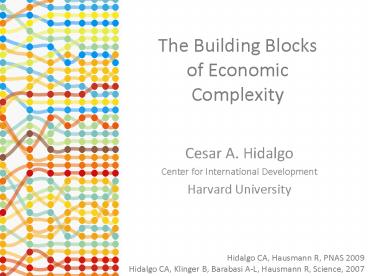The Building Blocks of Economic Complexity - PowerPoint PPT Presentation
1 / 34
Title: The Building Blocks of Economic Complexity
1
The Building Blocks of Economic Complexity
- Cesar A. Hidalgo
- Center for International Development
- Harvard University
Hidalgo CA, Hausmann R, PNAS 2009 Hidalgo CA,
Klinger B, Barabasi A-L, Hausmann R, Science, 2007
2
Adam Smith, The Wealth of Nations 1776
3
Adam Smith, The Wealth of Nations 1776
4
Adam Smith, The Wealth of Nations 1776
5
Can we measure complexity?
6
The Lego Theory of Economic Complexity
7
To create a product you need to know the
elements that go into it and how they connect
To create a Lego model you need to know the
pieces that go into it and how they connect
8
(No Transcript)
9
(No Transcript)
10
Can we approach these questions without looking
at the bucket of Legos or knowing what the
Building Blocks are?
We do not know a priori which Lego models are
more valuable than others
11
Countries
Capabilities
Products
12
(No Transcript)
13
(No Transcript)
14
We can try to grasp complexity, quantitative and
scientifically, as a problem of network structure.
15
Method of Reflections
Degree (Countries)
Degree (Products)
16
Method of Reflections
kc,1 Average ubiquity of products exported by a
country
Product p1
Country C1
Product p2
Country C2
Product p3
Country C3
Product p4
17
Method of Reflections
k1 Average diversification of a products
exporters
Product p1
Product p1
Country C1
Product p2
Product p2
Country C2
Product p3
Product p3
Country C3
Product p4
Product p4
18
Method of Reflections
Country
Product
19
Method of Reflections
Country
Product
20
The k0, k1 diagram
Primitive Productive Structure
Poorly Diversified Producing Common Products
Highly Diversified Producing Common Products
Average Ubiquity of a Countrys Productsk1
Highly Diversified Producing Exclusive Products
Poorly Diversified Producing Rare Products
Diversification k0
Complex Productive Structure
21
Dataset 1 (Year 2000)
Feenstra 129 countries 772 products (SITC-4)
How common are those Lego models
Number of Lego Models That You Make
Hidalgo, Hausmann (2009) Under Review
22
(No Transcript)
23
(No Transcript)
24
Hidalgo, Hausmann (2009) Under Review
25
(No Transcript)
26
Method of Reflections Predicts network
properties of future products
27
Method of Reflections Predicts network
properties of future products
28
CapabilitySpace
Country Capability
Product Capability
CapabilitySpace
Country Space
Product Space
Theoretical
Observational
Hidalgo Hausmann, PNAS 2009
Hidalgo et al. Science 2007
Bahar, Hausmann, Hidalgo (Forthcoming)
29
et Voila!!!!
30
Some answers to old questions
- What causes poverty traps and rich-country clubs?
- With few capabilities, there may be very low
returns to adding an additional capability - If you have many capabilities, there are many
potential new uses for any new capability - Why does what you produce matters?
- Because it affects the variety of the
capabilities you develop and hence the potential
basket of products that you could make in the
future - Countries converge to the level of income
implicit in their capabilities because they find
over time more possible combinations of the
capabilities they already have
31
Some answers to old questions
- What causes the resource curse?
- The fact that these activities require
capabilities that have few alternative uses - Follow the capabilities, not the raw materials
- Add value to your raw materials
- Finland
32
Conclusions
- Complexity has been at the heart of thinking
about growth and development since the times of
Adam Smith - but it has been absent from much of the
literature on growth empirics - We develop a method that can create measures of
complexity - and show how they relate to important aspects of
the development process
33
Grazie!!(more info _at_ www.chidalgo.com, or google
cesar hidalgo)Hidalgo et al Science
(2007)Hidalgo Hausmann Development Alternatives
(2008)Hidalgo Hausmann PNAS (2009)
Cesar A. Hidalgo, Research Fellow, Center for
International Development, Harvard
UniversityAdjunct Lecturer in Public Policy,
Harvard Kennedy School
Ricardo Hausmann, Director, Center for
International Development, Harvard
UniversityProfessor of the Practice of Economic
Development, Harvard Kennedy School
34
Networks and Economics Research Team
Center forInternationalDevelopment HarvardUniv
ersity
Ricardo HausmannDirector
Cesar A. Hidalgo Research Fellow
Bailey Klinger Research Fellow

